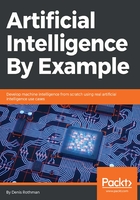
Analyzing and presenting the results
Pert knows the two-minute presentation rule.
If you have not captivated your manager or any audience within the two minutes of a presentation, it's over.
People will begin to look at their mail on their phones or laptops; pain replaces the pleasure of sharing a solution.
Pert decides to start the presentation with the following screenshot and a strong introduction:

Gain zone area
Pert points to the gain zone area and says:
From the computations made, that gain zone is only part of the losses of the present way AGVs are used in our company. It takes only a few locations into account. I would say that we could save 10% of the distances of our 25 AGVs on this site only. If we add nine other major sites in the world that adds up to:
10% of (25 AGVs * 10 sites) = a gain of 25 AGVs
That's because the AGVs are not going directly to the right locations but are wandering around unplanned obstacles.
Pert has everybody's attention!
In real life, I started my career with major corporations by making the following statement in similar cases (factories, warehouses, purchasing department, scheduling departments, and many other fields):
Pay me a percentage of that gain, and I will do the project for free until that is proven.
If the solution is mathematically solid and the data available, there is a risk to calculate to enter a corporation. When that is achieved once, it is easier the times after.
In this case, Pert's audience asks how this was estimated. The explanation is not simple but clear. The average distance from one location to another is 1 meter. The AGVs all start out from location 0 or 1. So the distance is strictly proportional to the locations in this particular example (which is not always the case).
To find the gain zone of a location, you draw a red horizontal line from location 80, for example, and a vertical line from distance 80 (add a couple of meters to take small variances into account).
None of the data points on the 80 location line should be beyond the maximum limit. The limit is 80 meters + a small variance of a few meters. Beyond that line, on the right-hand side of the figure, is where the company is losing money and something must be done to optimize the distances. This loss zone is the gain zone for a project. The gain zone on the k-means cluster results shows that some of the locations of 40 to 60 exceed 80 meters distance.
Something is wrong, and a project can fix it.